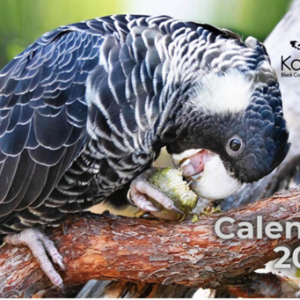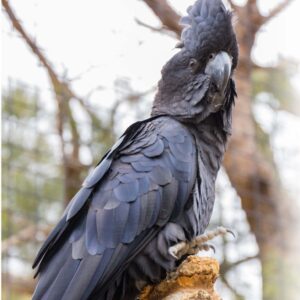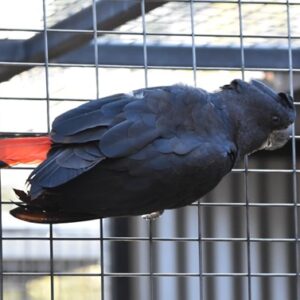Are black cockatoos endangered?
There are three species of black cockatoos only found in the South West of Western Australia and all of them are under threat of extinction. Each species continues to see rapid population declines year on year.
The Carnaby’s Black Cockatoo Cockatoo is listed as Endangered (IUCN 2022), The Baudin’s Black Cockatoo as Critically Endangered (IUCN 2022) while the Forest Red Tailed Black Cockatoo is listed as vulnerable (EPBC ACT).
Declining Numbers of black cockatoos
The number of black cockatoos that have been lost over recent decades is alarming. Of the three species only found in the South West of WA, the Baudin’s Black Cockatoo is the most at threat, with numbers estimated at just 3,500-4,500 mature individuals left!
In the past, flocks of thousands of black cockatoos used to blacken the sky of WA’s South West when passing through. Nowadays, only small flocks can be seen. The last place left where black cockatoos can still blacken the sky is the Gnangara Pine Plantation, when 5,000-7,000 Carnaby’s return seasonally to feed on the pinecones. But sadly, this last stronghold which hosts ~70% of the Perth-Peel’s Carnaby population is due to be 100% cleared, with no revegetation plans currently in place, in the next two years.
Due to the long periods involved in successfully raising young, these birds are on the decline with flock numbers falling and fewer young cockatoos reaching breeding status.
Black cockatoos generally lay one or two eggs in a breeding season. However, only one chick is usually reared to adulthood.
Eggs take around 29 days to hatch and young birds will take up to 18 months to learn how to feed themselves. While the mother incubates the egg, the father feeds her until the hatching of the chick (or chicks if the couple is lucky).
Their steady decline is due to:
- Destruction of forests and native bushland
Large scale clearing in the wheatbelt and Banksia and Tuart woodlands on the Swan Coastal Plain in the Perth area. - Habitat fragmentation (cockatoos need to travel further to reach food and shelter)
Bushfires (destroying food sources and nesting hollows) - Increased competition for nesting hollows from Feral European Honeybees, Corellas and Galahs.
- Motor Vehicle Collisions
- Illegal shooting
- Illegal poaching
- Raven attacks in Perth and suburbia
- Severe weather events
Habitat loss is the main threat to the decline of the black cockatoos
Sadly, due to land development in Perth & surroundings and the clearing of the Wheatbelt for agriculture, black cockatoos, like many other native animals, are running out of spaces to live. If a black cockatoo is eating Marri nuts, each cockatoo will need to eat around 100 nuts each every day!
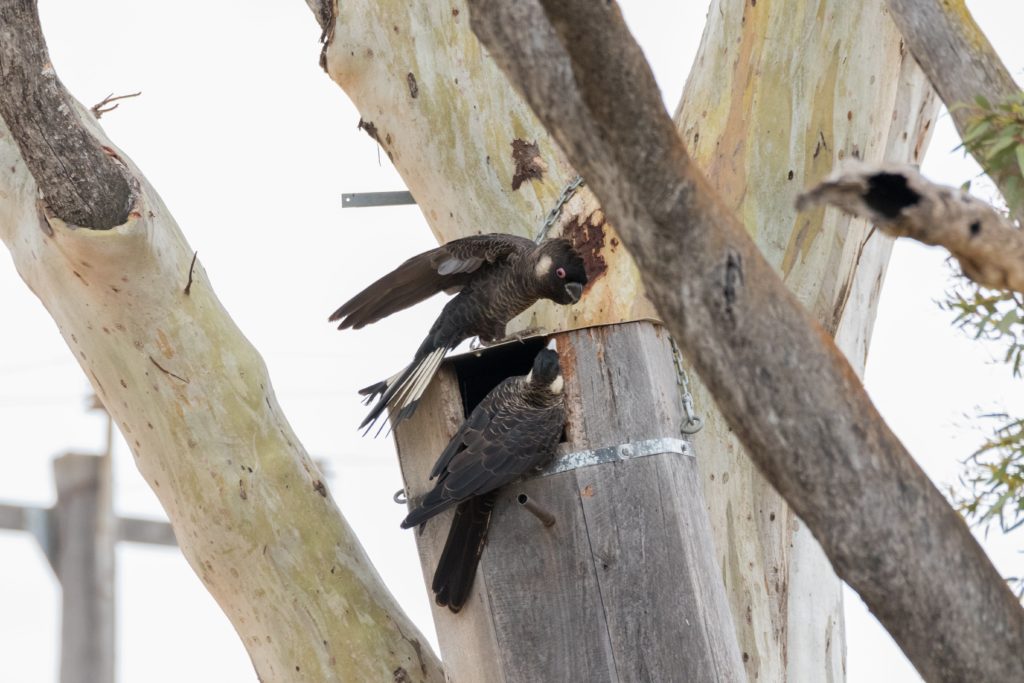
Seasonal events such as bushfires can take a toll
Seasonal events can also have a catastrophic effect on food sources and young birds. Sudden ‘freak’ hailstorms that can sweep through the city during a Perth summer in just a matter of minutes, can destroy pockets of fruit trees in the outer suburbs, other growing food sources and in fact, the birds themselves. Bushfires, droughts, flooding and high winds can also bring about casualties during the breeding season.
In addition to the issues of safe breeding and food sources, there is also the obvious clash of humans and birds living in such close proximity. There are a number of phone calls received each week at Kaarakin, requesting bird rescues – injured birds stuck in trees, victims of our roads after being hit by vehicles, hitting power lines, windows of buildings, or victims of the pets people keep. One Carnaby’s was accidently hit by a golf ball in 2019. He made a full recovery and spent one night at our centre before being released.
Orchardists
Orchardists and black cockatoos – in fact at number of parrot species – have been increasingly in conflict in recent decades, with each desperately trying to provide for their own families (both cockatoos and farmers) and benefit from the fruits of orchards.
Unfortunately, food shortages have made the birds less inclined to be shoo-ed away as there is little else for them to find to feed themselves and their young.
Due to the human destruction of the natural environment in the greater Perth area and beyond – clearing land for cities, homes and roads, we have encroached on the natural territory of the black cockatoos.
They naturally return to the same place each year to breed, bring up their young and feed ferociously to sustain them all during this time. However, often they are now returning to cityscapes and suburbia, making food sources and nesting sources scarce.
Unfortunately, those who have orchards can be “bombarded” during a period of peak growth (both in the orchards and of cockatoos themselves). Cockatoos, such as the Baudin’s cockatoo revel in the fields of nuts, seeds and fruits growing wherever they can find them.
The birds have the ability to cause enormous damage – stripping an orchard and leaving behind a trail of damaged trees and ruined crops in a matter of just a day or two.
This can be devastating for farmers – not to mention the financial loss of a year’s investment. As the birds are not able to be shot, or even harmed during these interactions, some creativity is needed to keep the birds at bay. Cockatoos are highly intelligent and can quickly learn to be unafraid of deterrents such as hanging CD’s in trees to reflect light, hanging silhouettes of large birds of prey on high wires hovering above orchards, or setting of a gun-shot sound every 15 mins throughout the daylight hours.
Ideally, orchards need to be netted in a way that prevents birds (and weather events like hail) from harming crops. However, the prohibitive cost of this means farmers are rarely able to do this.
There are penalties of up to $10,000 for shooting black cockatoos under the Wildlife Conservation Act, and under Commonwealth legislation, fines of up to $250,000 for an individual and $500,000 for a corporation.
Sadly, it is estimated that around 200 birds are shot each year (source: WWF).
To report an injured cockatoo or provide information about illegal shootings, contact the Wildcare Helpline on 9474 9055 or the Parks and Wildlife Manjimup office on 9771 7988.
Conflict with Human Environments
Humans have systematically moved into areas and environments previously occupied by wildlife, and a range of bird species. These areas have been their feeding, resting, nesting and breeding sites
However, the vast clearing and urban building within these areas have often come into conflict with the black cockatoos. Roads, vehicles, buildings, powerlines, vast areas of concrete and clearance of all vegetation have contributed to the decline in the flocks we knew in our childhoods.
One of the biggest problems has been the clearance of vital feeding and nesting sites. The other has been the clash of birds with ‘human infrastructure like powerlines, buildings, fencing and farming methods that may include poisoning/fertilising and of course, roads and fast-moving vehicles.
These are relatively large birds and take longer to actually lift off and clear of the vehicle once they are started. They are often struggling to get that initial lift when the rapidly approaching car is too fast for them and tragic collisions occur. The majority of black cockatoos coming into our care result from vehicles strikes and raven attacks.
They are frequently in flocks which again, slows down the clearance of these birds from danger once the initial alarm has been sounded.
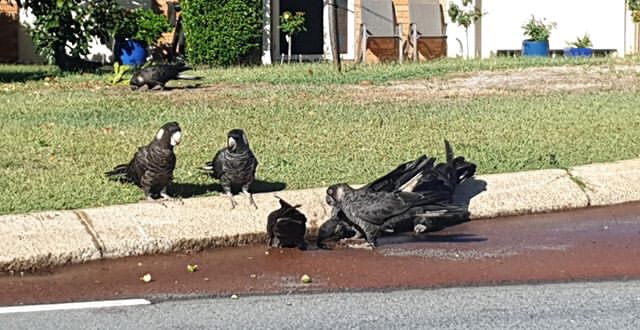
Raven attacks are on the rise
Approximately 25% of the black cockatoos coming into our care suffered raven attacks. A decade ago, red tail black cockatoos started to move into the Perth and its suburbs and adapted to eat non-native seeds such as cape lilac. Ravens are very territorial birds and perceive the red tail cockatoos as a non-welcome species. As Red-tailed black cockatoos are very shy birds, they get picked at by ravens, their tail feathers are pulled and the ravens will continue picking at the black cockatoo on the ground until dead. Unfortunately, there are too many ravens in Perth and the issue is exacerbated by the easy food supplies they get from rubbish bins which are not properly closed.

How you can help
- Support Kaarakin: Virtually adopt a black cockatoo, browse our online shop, come for a visit (private tour or open tour weekend), or support one of our projects
- Spread the word
- Protect remaining bushlands
- Plant a black cockatoo/ native bird friendly garden and install a bird bath
- Report any injured black cockatoos to Kaarakin or bring the cockatoo to a vet
Consultations
Kaarakin is able to provide advice for projects likely to impact black cockatoo habitat and welfare. For more information please contact us:

